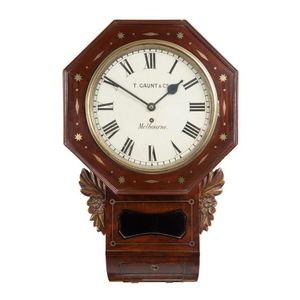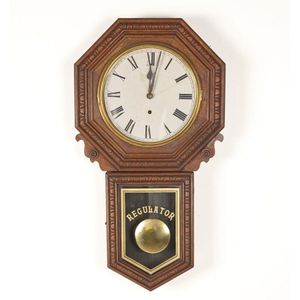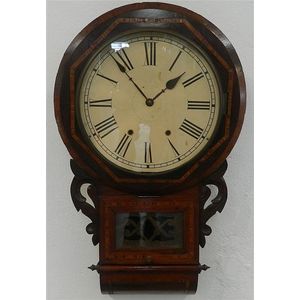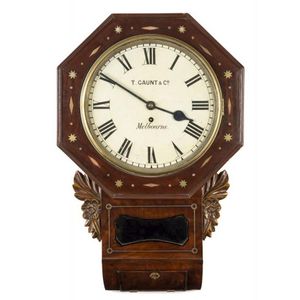19th Century T. Gaunt & Co. Wall Clock
T. Gaunt & Co. wall clock with fusee movement in cedar and mogany case, 19th century, dial marked 'T. Gaunt, Melbourne', with key and pendulum, 68 cm high, 42 cm wide
You must be a subscriber, and be logged in to view price and dealer details.
Subscribe Now to view actual auction price for this item
When you subscribe, you have the option of setting the currency in which to display prices to $Au, $US, $NZ or Stg.
This item has been sold, and the description, image and price are for reference purposes only.
- Movement - The technical name for the workings of a clock or watch, and does not include the dial or case.
- Fusee - The fusee movement was used in clocks and pocket watches from the mid 17th century. The fusee is a cone shaped drum within the works that is linked to the barrel of the spring, usually by a length of chain.
As the mainspring loses its tension over time, the cone shaped barrel compensates for this by increasing the tension, by pulling the mainspring tighter, thus ensuring the time remains constant.
Use of the fusee in clocks was superseded by the "going barrel" in the mid 19th century and for pocket watches at the beginning of the 19th century.
The fusee continued to be used in marine chronometers until the 1970s. - Pendulum - The pendulum was discovered around 1602 by Galileo Galilei, and was adopted for time keeping by the Dutch mathematician and natural philosopher, Christiaan Huygens, who excelled in astronomy, physics, and horology.
The pendulum comprises a metal rod usually of brass or steel with a metal disk, known as a bob, at the end. The movement of the pendulum is driven by weights or a spring, and as a pendulum swings in a regular arc, it was found accuracy could be controlled to within a few seconds a week.
Timekeeping can be adjusted by changing the height of the bob on the rod, making the pendulum either swing slower or faster.
The disadvantage of the pendulum was that changes in temperature also changed the length of the pendulum, interfering with the accuracy of the clock, and so in the 18th century two types of mercurial pendulums were invented which countered the movement in the steel rod.
The pendulum was the world's most accurate timekeeping technology until the invention of the quartz clock, regulated by a quartz crystal, in 1927.
This item has been included into following indexes:
Visually similar items

A brass inlaid mahogany railway clock, T. Gaunt & Co. Melbourne, 19th century, 66 cm high
Sold by
in
for
You can display prices in $Au, $US, $NZ or Stg.

A 19th century American regulator wall clock, oak case with brass bezel and octagonal surround above the original glass pendulum door. Height 85 cm.
Sold by
in
for
You can display prices in $Au, $US, $NZ or Stg.

Antique Ingraham wall clock, 70 cm high approx, key and pendulum included
Sold by
in
for
You can display prices in $Au, $US, $NZ or Stg.

A 19th century drop dial wall clock clock face replaced minute hand not working
Sold by
in
for
You can display prices in $Au, $US, $NZ or Stg.
